K2UN. the beginning
United Nations Amateur Radio Goes on the Air
AFTER TWELVE MONTHS of joint planning and co-operation between the United Nations Department of Public Information and the International Amateur Radio Union, K2UN—the United Nations Amateur Radio Club’s station—went on the air for the first time with a broadcast from Lake Success on the evening of May 17 in 1948.
The powerful station flashed its first official signal to the world at 6 P.M. (EDT) when, George W. Bailey President of the International Amateur Radio Union and of the American Radio Amateur League, directed the station’s antenna towards Europe, and spread the word that a special United Nations certificate would be awarded to the amateur radio operator who sent the first reply to the signal. Despite local thunderstorms over New York, a reply came through within a few seconds from Victor E. Motto, an amateur operating station I1RM, in Como, Italy. In the studio at Lake Success, the microphone was picked up by Benjamin Cohen, Assistant Secretary-General for Public Information, who broadcast a congratulatory message in Italian to the amateur in far away Italy.
Within a few minutes, K2UN picked up a second reply from Yves Naintre, in Paris, to whom greetings in French were broadcast by Mr. Cohen and by Adrian Pelt, Assistant Secretary-General for Conference and General Services.
The next reply followed in a few seconds from an amateur speaking from Wiesbaden, Germany, who identified herself merely as "Christine," wife of an American army sergeant stationed in Germany. This operator received a message of greetings from Brig. Gen. Frank E. Stoner, United Nations Chief Communications Engineer, who originated and planned K2UN. Contacts were then made in rapid succession with amateur radio operators in Cuba, Bermuda, and a dozen American states. During the few hours following the official opening of the station, messages were picked up from amateurs in all parts of the world.
The new station has two transmitters, each of one thousand watts, the maximum input-power permissible in the United States. One transmitter, operating on the80- and 40-metre bands and using "doublet" antennas, will be able to cover a large part of the United States from the transmission point at Lake Success. The other transmitter, with a rotating beam antenna, will broadcast in the high ends of the 20- and 10-metre bands, and will be capable of contacting radio amateur operators all over the world.
Goodwill by Wireless
The original idea of establishing a United Nations amateur radio station was first suggested by General Stoner over a year ago. He felt that the creation of a high-powered transmitter, operating under the auspices of the United Nations, would be of value both to amateur radio operators throughout the world, and to the Department of Public Information in promoting international goodwill, it would also help to (develop existing world contacts among amateur radio operators throughout the world.
The plan was enthusiastically accepted by the International Amateur Radio Union, which groups all national societies of licensed amateur radio operators. It has some 100'000 members. After technical and other problems had been settled, an agreement was signed between the Department of Public Information and the International Amateur Radio Union. This agreement, which remains in effect for one year but may be renewed annually with the consent of both parties, specifies that the amateur operators will handle only material not otherwise broadcast by international or domestic services.
The new station will observe United States regulations governing the operation of amateur stations, since it is nearest to United States amateurs.
Already operators in many countries have evinced keen interest in the project and have offered every assistance towards making the plan a success. When the station’s transmitters were first tested early in May, the United Nations received speedy and positive evidence that its signal would be a good one. In the middle of the test the signal was picked up by an amateur operator in Italy who flashed back this signal: "Wonderfully clear signal. Can this be K2UN?"
An affirmative signal was flashed to the operator in Italy, with the information that K2UN would be officially on the air on May 17, at 6 P.M. Back came an instant reply: "Good! I shall be listening. I have been standing by for days waiting to be the first to pick you up…." Other amateur operators in the Middle West region of the United States and in Canada also picked up test signals sent out by K2UN.
The exact type of material to be handled by the station has not yet been determined. However, it is planned to give specific information requested by individual amateur radio operators. According to present arrangements, K2UN will ultimately be on the air daily from 4 P.M. (EDT) until midnight, transmitting and receiving messages. It is operating at present from 7 P.M. to 10 P.M. (EDT), and occasionally later.
Inter-Professional talks
Another project is to arrange periodic talks between experts in the various divisions of the United Nations Secretariat, and the specialized agencies, and amateur operators who, in their daily lives, practice in similar professional fields. For instance, an expert from the Legal Department might talk to operators who are themselves lawyers. A representative of tile Food and Agriculture Organization may talk with a farmer in New Zealand or Canada on mutual problems, or a medical expert from the World Health Organization with a doctor who operates his amateur radio in Bombay or Brussels.
In the event of international or national emergencies, K2UN will also play its part in serving the public in such ways as handling traffic from and to, and generally maintaining contact with, isolated areas.
The studio, which has a glass-panel front, is located just off the main conference corridor of the headquarter building at Lake Success.
About fifty members of the United Nations Secretariat are already active members of the club. The station will be under the supervision of a licensed radio operator. As classes progress, Secretariat workers will be licensed.
The club is bound by its newly ratified Charter to "preserve and foster the spirit of fellowship among the radio amateurs of the world, to promote international awareness of, and interest in, the United Nations’ role of building a better world, and to build prestige for the United Nations through radio amateurs." The station’s call letters are symbolic of United Nations’ hospitality and goodwill - K2UN, standing for "Come to the United Nations.,,
Present at Ceremony
Among the persons prominent in radio who were present at the opening of K2UN were the following (the call letters of those who are amateur operators are shown): E. Finley Carter, vice-president of the Sylvania Products Co.; Morton Kahn (W2KR) president of the Tempco Co., which built the equipment for K2UN; Larry Kashman (W2IOP), editor of CQ, an amateurs’ magazine; L. H. Vydre, of the Canadian Broadcasting Co.; Larry Cumming, technical secretary of the Institute of Radio Engineers; and Peter Lovelock (XG2AIS), an editor of the British Short-Wave Magazine. William Hayes (W2BSP), of the Sperry Gyroscope Co., and Donald Merton (W2UOL), president of the Nassau County Amateur Radio League, alternated in operating the station.
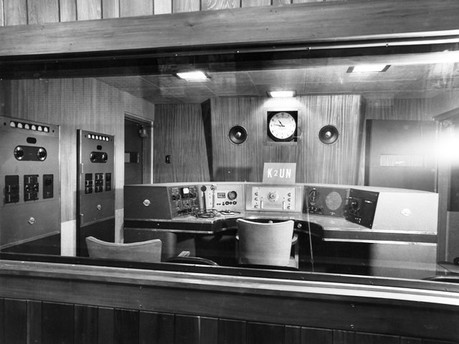
The studio of the United Nations Amateur Radio Club, the Tempco Consoles and the two transmitters at left
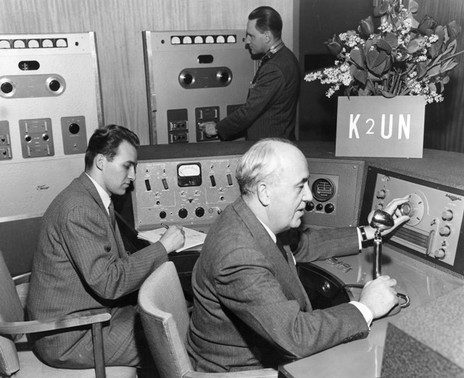
Testing K2UN, Brig Gen. Frank E. Stoner, Chief Communications Engineer, operating the station, while one assistant, Sandford Major, adjusts a transmitter and another, Robert Saron, notes contacts in the log.
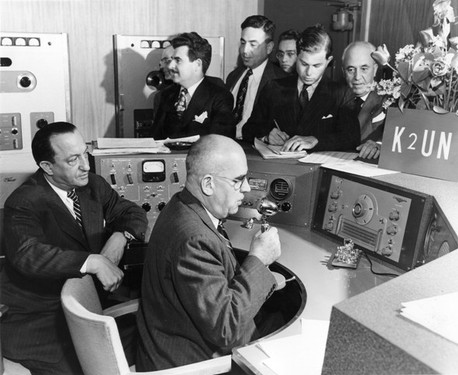
George W. Bailey, W2KH, President of the International Amateur Radio League, broadcasts an opening message as Benjamin Cohen, Assistant Secretary-General for Public Information, looks on.
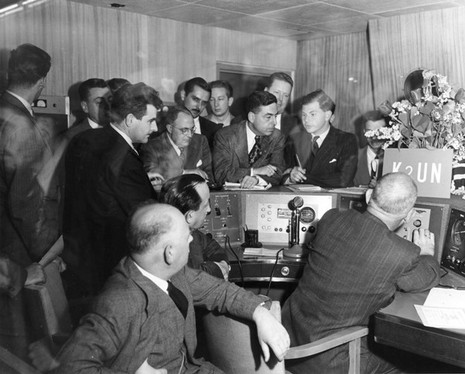
Mr. Bailey, W2KH, operates the station, and William Hayes of Sperry Gyroscope Company, adjusts the panel. Looking on are Mr. Cohen and (forground) Adrain Pelt, assistant Secretary-General for Conference and General Services.

The first certificate to be awarder by UNARC was presented to George W. Bailey, who operated K2UN on it’s opening night. The second certificate was awarded to Victor E. Motto, of Como, Italy, who was the first amateur radio operator to reply.
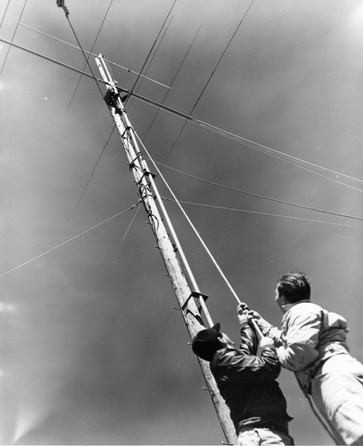
Workmen erect specially designed rotary beam antennas for the United Nations Amateur Radio Club’s Station K2UN, outside the U.N. interim headquarters at Lake Success.
Technical details:
These antennas are for use on the ten and twenty metre bands. The four element wide spaced 10 metre band beam is mounted 10 feet above the 3 element 20 metre beam, both atop a 90 foot wooden pole. They are rotated by a B-20 bomber propeller pitch motor which has a gear ratio of 9000 to 1, and turns the antenna at the rate of 1 revolution per minute. The motor is controlled by a selsyn indicator compass control operated by a switch at the station’s control desk inside the building.
K2UN is still a call which could be used for any activities of the club outside UN premises. Vince Sullivan, K2FC, is responsible for this call.
Text and photos are courtesy of :
The United Nations Bulletin, June 1, 1948
The United Nations Photo Unit
Max de Henseler, HB9RS
